A Quick Guide to Username and Password Authentication
Username and password authentication remains a foundational security method, despite modern alternatives. This guide explores how it works, its benefits, challenges, and how to strengthen it. Learn how to secure login flows as you prepare for a passwordless future.
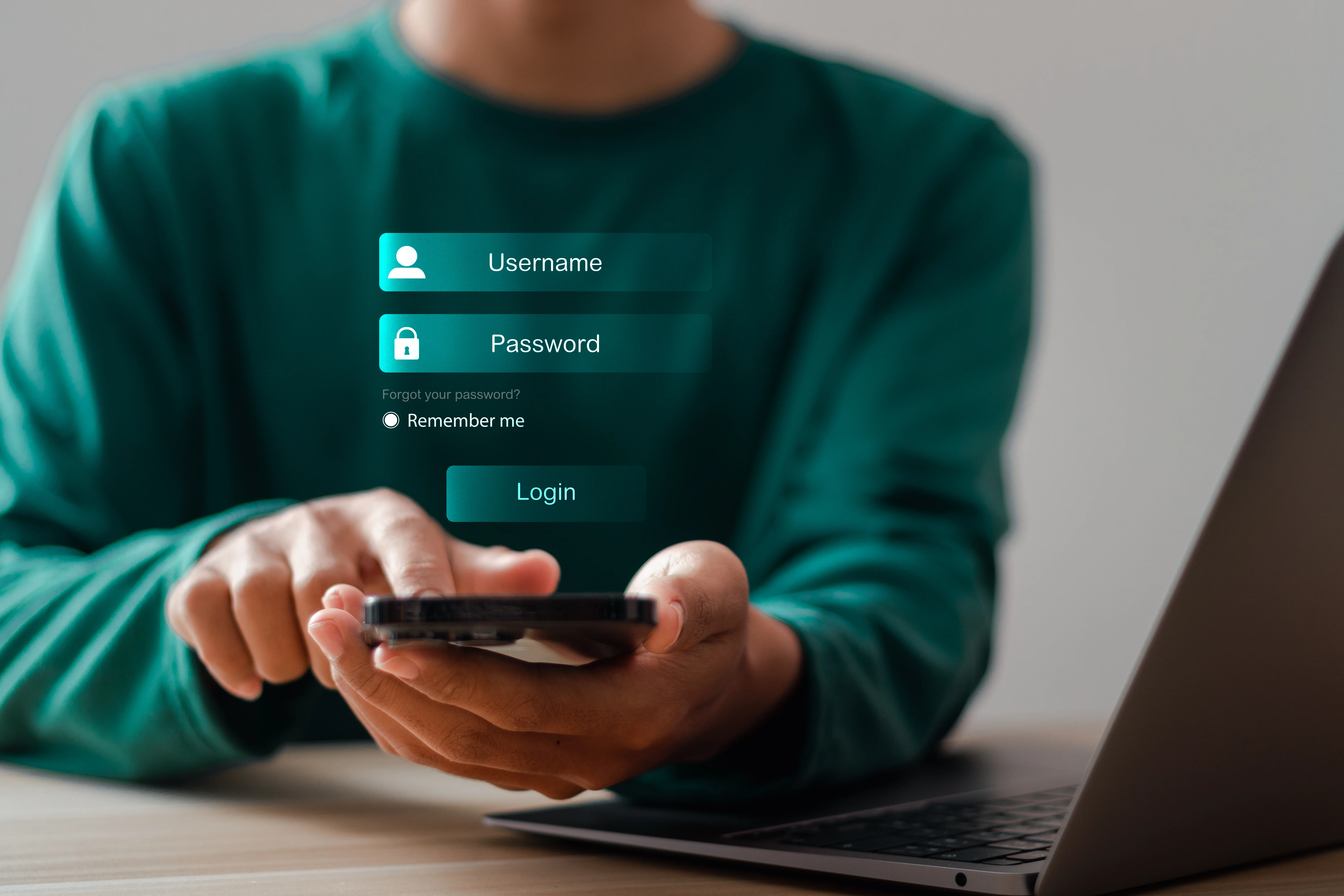

Learn How to Master Digital Trust

The State of Consumer Digital ID 2024

Top CIAM Platform 2024
Introduction
In the modern digital ecosystem, security and convenience walk a fine line. From financial transactions to personal data storage and enterprise operations, verifying digital identity is critical. Username and password authentication is still the most recognizable and widely used method for confirming user identity.
But despite its familiarity, is it still the best method? How do businesses secure it effectively, and what’s replacing it in modern security frameworks?
This guide offers a detailed breakdown of how username and password authentication works, how to implement it properly, common pitfalls, and why organizations are shifting toward passwordless systems. Whether you’re a developer, product manager, or security leader, this content is for you.
What is Username and Password Authentication?
Username and password authentication is the most traditional and widely used method of user authentication in the digital landscape.
It relies on a straightforward principle: a user must prove their identity by entering two specific credentials—a username, which is a unique identifier such as an email address, mobile number, or employee ID; and a password, which is a private, secret string known only to the user.
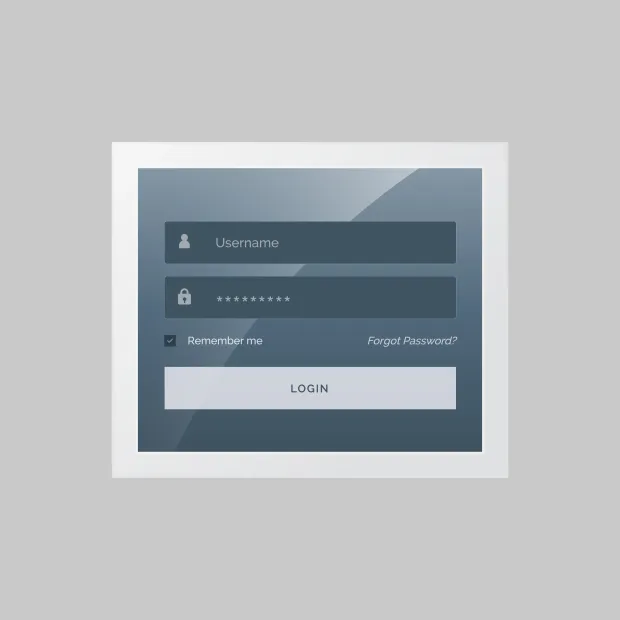
Once these credentials are entered, the system performs a validation check. It securely compares the input with a stored version of the login username and password combination— typically a hashed and salted representation saved in the authentication database.
If the match is successful, the user is granted access to the application or system. This process may also generate a username password authentication token, allowing the system to recognize the user during their session.
Why is Username and Password Authentication so Common?
Username and password authentication has remained a dominant login approach for several reasons, including:
-
Low Barrier to Entry: It doesn’t require any additional hardware or complex software installations. Users only need to remember their credentials.
-
Universal Compatibility: Almost every digital service, from personal apps to enterprise platforms, supports sign in username and password as the default login mechanism.
-
Cost-Effective: For developers and businesses, implementing password authentication is relatively inexpensive and easy to deploy.
Real-World Examples
-
Gmail or Outlook: Users enter their login user password credentials to check emails.
-
Online Banking: Customers authenticate using a login username and password, often followed by an OTP for additional verification.
-
Enterprise Systems: Employees sign into portals with a corporate ID and password, often tied to multi-factor authentication (MFA) to strengthen user password management. A great example is Harry Rosen, which implemented LoginRadius to secure internal and customer access using robust username and password authentication and MFA—ensuring both security and a seamless experience across platforms.
This simplicity, however, comes with challenges—which is why modern systems often explore hybrid and passwordless authentication approaches for stronger security.
How to Implement Password Authentication
Implementing a secure password authentication system goes far beyond simply checking if the username and password match. In today’s threat-heavy digital environment, businesses must adopt comprehensive practices to ensure that user credentials are protected during every phase of the login cycle—from registration to logout.
At its core, username and password authentication works by validating a unique user identity (username) and a secret key (password). But the real security comes from how those credentials are processed, stored, and managed over time.
A properly implemented user authentication flow prevents unauthorized access, supports compliance with global security standards, and enhances user trust. Let’s quickly understand what needs to be done:
1. User Registration Process
When users sign up, you must enforce strict rules around creating username and password combinations. This includes:
-
Enforcing password complexity (uppercase, lowercase, symbols, and numbers)
-
Real-time strength validation indicators
-
Blocking common passwords and dictionary words
-
Enabling CAPTCHA and rate-limiting to block bots and brute-force attempts
Most importantly, passwords should never be stored in plaintext. Instead, they should be hashed using secure algorithms like bcrypt or Argon2, with a unique salt applied to each hash to prevent rainbow table attacks.
2. Login Authentication Flow
During login, the system compares the entered password—hashed in real time—with the stored hash.
If verified, the system generates a username password authentication token (such as JWT) to represent the session. This token is essential for accessing authorized resources securely and managing session continuity across platforms.
3. Session Management
Secure session management is vital. Implement:
-
HttpOnly and Secure cookie flags
-
Idle session timeouts
-
Token expiration
-
Re-authentication prompts for high-risk actions (like password changes)
4. Password Recovery and Logout
Robust systems provide secure recovery flows, using short-lived tokens sent via email or SMS. Logout mechanisms should immediately revoke the session and delete associated tokens on all devices.
The LoginRadius Advantage
LoginRadius offers a plug-and-play implementation of username authentication through its Standard Login feature.

With built-in support for secure password storage, brute-force protection, risk-based authentication, and user password management, LoginRadius ensures your authentication flow is secure, scalable, and compliant out-of-the-box.
You can explore the full documentation here: LoginRadius Standard Username Login
Benefits of Username and Password Authentication
While modern alternatives like biometrics and passwordless login are gaining traction, username and password authentication continue to play a foundational role in digital identity management. Its longevity and adaptability have allowed it to remain a preferred user authentication method across a variety of industries, from education and healthcare to banking and enterprise IT.
Here’s why this method remains highly relevant today:
1. Universality and User Familiarity
One of the biggest strengths of username and password authentication is its simplicity and familiarity. It’s a universally understood concept, requiring no user education or training. Whether someone is signing in to an online course, accessing their email, or logging into a mobile app, the login username and password flow is instantly recognized. This ease of use significantly lowers the barrier to entry and boosts user adoption rates.
From teenagers to elderly users, almost everyone has used a sign in username and password at some point. This makes it ideal for consumer-facing applications where the user base spans various technical skill levels.
2. Cost-Efficiency and Scalability
Unlike more complex solutions like biometric scanners or hardware-based tokens, password authentication requires no additional hardware. This makes it a highly cost-effective option for startups, SMEs, and large-scale enterprises.
The scalability of this method also stands out. Whether you’re managing 100 users or 10 million, username password authentication systems can handle the load efficiently with the right infrastructure in place.
Cloud-based identity platforms like LoginRadius ensure that scaling your authentication environment doesn’t compromise performance or security. In fact, LoginRadius is purpose-built to handle both, offering seamless scalability while maintaining the highest standards of data protection—learn how LoginRadius handles scalability and security here.
3. Foundational Security Layer
While not infallible on its own, login user password authentication serves as an essential first layer in multi-layered security frameworks. It is often combined with additional safeguards such as Multi-Factor Authentication (MFA), CAPTCHA challenges, and device recognition for improved threat resistance. Here’s how easy it is to implement captcha in the LoginRadius console:
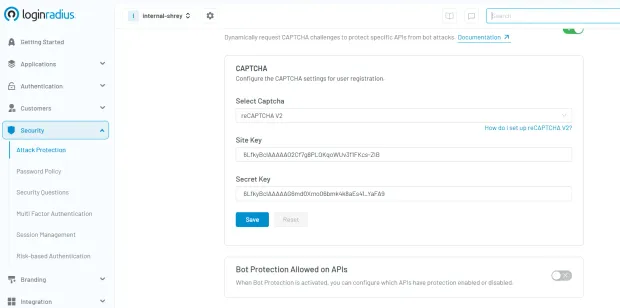
When combined with modern user password management best practices—like hashed and salted storage, session tokenization, and behavioral monitoring—it forms a secure, user-friendly authentication strategy.
4. Flexibility and Integration
Another major benefit is its adaptability across platforms and technologies. Whether your application is mobile, web-based, or embedded within enterprise systems, username and password authentication can be seamlessly integrated via SDKs, APIs, or third-party identity providers.
A great example of this in action is how A+E Networks implemented LoginRadius to streamline identity access across its global media properties. By integrating flexible user authentication mechanisms—including username password authentication—they improved engagement and ensured a seamless, secure experience for millions of users.
5. Policy Enforcement and Admin Controls
From a governance standpoint, administrators can define granular password policies—enforcing rules like password expiration, complexity requirements, and historical checks. They can monitor failed login attempts, detect unusual patterns, and set up alerts for potential security incidents.
This level of control makes user authentication more predictable and manageable for security teams, especially in regulated industries like healthcare (HIPAA), finance (PCI DSS), and education (FERPA).
Additionally, user preference can’t be overlooked. Some users—due to privacy concerns, comfort with familiar methods, or lack of access to compatible biometric devices—may still opt for traditional username and password authentication.
Furthermore, regulatory compliance in certain jurisdictions or industries may still require or reference password-based controls as part of accepted security frameworks. Until global standards evolve more uniformly toward passwordless and biometric models, username-password authentication remains a necessary component of many compliance strategies.
Lastly, legacy system compatibility is a practical factor. Many enterprise applications and infrastructure components still depend on username and password authentication, making it critical for organizations undergoing gradual digital transformation.
Challenges of Password Authentication
While username and password authentication continues to serve as a default login mechanism across countless applications, it comes with inherent security, usability, and compliance challenges. As cyberattacks become more sophisticated and user expectations for convenience increase, the weaknesses in password authentication systems have become more pronounced.
Here’s a closer look at the major pain points associated with password-based login methods:
1. Human Error: The Weakest Link in Security
The biggest vulnerability in any user authentication system is human error. Weak or reused passwords like “password” and “123456” remain common, and many users store their login user password data insecurely.
To address this, developers must implement strong user password management tools—like real-time strength meters and policy enforcement. Explore best practices for password security and compliance to build more resilient systems.
2. Credential Breaches: A Gateway for Attackers
One of the most dangerous risks in username password authentication is credential reuse. When attackers gain access to one set of credentials from a data breach, they often use automated bots to perform credential stuffing—trying those same login username and password pairs on other services.
This type of attack has become increasingly common, fueled by massive dumps of stolen data available on the dark web. Even if your platform itself has never been breached, it’s vulnerable if users recycle credentials compromised elsewhere.
Attackers can execute thousands of login attempts per minute, exploiting this method with ease if no safeguards are in place. That's why technologies like rate limiting, IP blacklisting, and CAPTCHA are critical defenses.
To understand more about how these threats operate and how to prevent them, refer to our detailed post: Common Vulnerabilities in Password-Based Login
3. Phishing Attacks: Deception is Easier Than You Think
Another severe risk is phishing—where users are tricked into entering their sign in username and password into fraudulent websites that mimic real login pages. Phishing has evolved beyond generic email scams; today, attackers use personalized messages (spear phishing), cloned sites, and even fake domain certificates to deceive users.
Even security-aware users can fall victim, especially if an attacker spoofs a trusted domain or compromises a legitimate site temporarily.
While Multi-Factor Authentication (MFA) provides an additional layer of security, not all forms of MFA are phishing-resistant. For example, OTPs sent via SMS can still be intercepted or used in real-time by a man-in-the-middle attacker.
Organizations should encourage phishing-resistant methods such as device-based authentication (passkeys), WebAuthn, or biometric verification to close this loophole.
4. User Friction and High Recovery Costs
Password fatigue is real. With users managing dozens—or even hundreds—of accounts, remembering complex passwords becomes an overwhelming task. This often leads to password reuse or insecure storage methods, as discussed earlier.
From a business standpoint, forgotten passwords are a costly problem. Each password reset request could translate into a support ticket, customer frustration, or even abandoned sessions. Delayed access also negatively impacts engagement and conversion rates.

A smoother experience can be achieved through smarter user authentication practices—such as providing intuitive recovery workflows, enforcing fewer but stronger credentials, and offering secure backup options (email, SMS, or authenticator apps).
LoginRadius’s CIAM platform helps businesses reduce this friction through secure, user-friendly authentication and recovery flows. Learn more about these improvements in our post on Best Practices for Username and Password Authentication
5. Compliance Risks and Regulatory Liability
In sectors like healthcare, finance, and education, the risks of mismanaging username and password authentication go beyond technical consequences—they result in legal and financial exposure.
Frameworks such as GDPR, CCPA, and PCI DSS mandate secure user password management practices. This includes everything from password hashing and storage policies to incident response and user consent tracking.
Failing to comply not only results in penalties and lawsuits but can severely damage your brand’s reputation. For example, storing passwords in plaintext, failing to secure recovery processes, or not logging login attempts could all be violations under multiple international standards.
To maintain compliance and reduce liability, businesses must continuously assess and improve their password authentication practices—ideally supported by a flexible, policy-driven identity platform like LoginRadius.
Despite its convenience and universal appeal, password authentication alone is no longer sufficient in the face of modern security threats. Without strong infrastructure and forward-thinking strategies, it becomes a liability rather than a safeguard. For long-term success, businesses should invest in hybrid and passwordless systems that elevate both user experience and security posture.
Best Example of Robust Username and Password Authentication
To understand how username and password authentication can be both secure and user-friendly, let’s explore a real-world enterprise-level use case: the Single Sign-On (SSO) Portal for a global organization.
This scenario highlights a robust implementation of login username and password systems, demonstrating how thoughtful design, security policies, and modern best practices work together to create a reliable user authentication experience.
Use Case: Enterprise SSO Portal
Large enterprises often manage multiple applications, platforms, and internal systems. To simplify access and enhance productivity, these organizations implement a single sign-on (SSO) portal where users authenticate once to gain access to multiple authorized services.
In a well-structured username password authentication setup for such a portal, the system may include:
-
Unique Usernames: Users sign in with identifiers tied to their employee ID or verified corporate email address, ensuring account traceability.
-
Strong Password Requirements: The system enforces password complexity rules—minimum of 12 characters, including uppercase, lowercase, numbers, and symbols. Passwords must be changed periodically, and password history is tracked to avoid reuse.
-
Token-Based Session Management: Upon successful authentication, a username password authentication token, like a JWT, is issued. This token enables session continuity across systems while maintaining user state securely.
-
Session Expiry Controls: Tokens expire after 15 minutes of inactivity or when you log out, minimizing the risk of unauthorized access from idle sessions.
-
Adaptive Multi-Factor Authentication: Based on risk signals like location, device fingerprint, or time of access, the system may trigger an additional verification step through adaptive MFA, such as OTP or push notification to a registered device.
-
Centralized Monitoring and Reporting: Every login attempt is logged in a central dashboard. Anomalies—like repeated failed logins or unusual locations—trigger alerts for the IT security team.
Here’s how quickly you can setup SSO through various integrations in the LoginRadius dashboard:
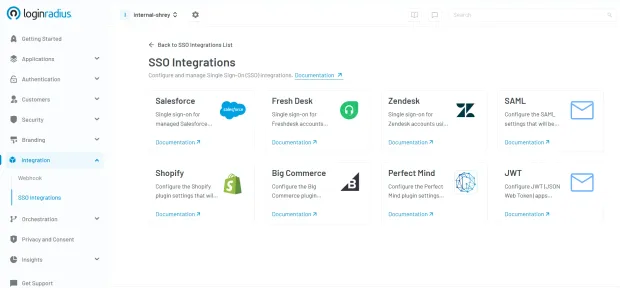
If you need more understanding of how SSO can help your business, see how one of our clients, Tiroler Tageszeitung (TT), powered a seamless login journey with LoginRadius' SSO—one login, multiple web properties, zero hassle! See how TT transformed user access.
Additional Layers of Security and Usability
This implementation goes beyond basic sign in username and password workflows. It’s designed to strike a balance between user authentication convenience and enterprise-grade security, supported by:
-
Account Lockout Thresholds: After a certain number of failed login attempts, the system temporarily locks the account or requires additional verification to prevent brute-force attacks.
-
Granular Access Control: Based on job role, department, or project, users can access only specific applications—reducing exposure to sensitive data.
-
Audit Trail for Compliance: Every login event is recorded, enabling auditability for standards like SOC2, HIPAA, and GDPR.
Why This Model Works
Balances Usability and Control: Employees can access multiple tools with a single authentication point, reducing password fatigue while ensuring high security standards.
Adheres to Compliance Standards: Regulations require secure user password management, robust logging, and granular access. This model fulfills all key checkpoints.
Scales Across Teams Globally: With cloud-based infrastructure and tokenized sessions, this setup easily supports thousands of employees in different geographies and time zones.
A secure username and password authentication system like this ensures that enterprises maintain operational efficiency without compromising on cybersecurity. When paired with solutions like LoginRadius, businesses can customize these capabilities further—integrating SSO, MFA, adaptive authentication, and real-time monitoring for a seamless yet secure user experience.
Best Practices for Password Storage and Transmission
Implementing username and password authentication is only half the battle; securing how those credentials are stored and transmitted is just as critical. Mishandling password data—whether in transit, at rest, or during reset flows—can lead to massive breaches, compliance violations, and irreparable damage to user trust.
Below are essential best practices that organizations should adopt to safeguard login username and password credentials throughout the authentication lifecycle.
1. Hash, Don’t Encrypt Passwords
One of the most fundamental principles of secure user password management is to never store passwords in a retrievable format. Instead of encryption (which is reversible), passwords must be hashed—a one-way function that generates a unique output for every input.
Secure hashing algorithms like bcrypt, Argon2, or PBKDF2 are ideal because they include computational delay features, which slow down brute-force attacks. These algorithms are designed specifically for password storage and make it extremely costly for attackers to guess passwords even if they gain access to the hashed database.
Avoid outdated algorithms like MD5 or SHA-1, which are susceptible to collision attacks and can be cracked within seconds.
2. Always Salt Hashes
Salting means adding a unique, random string (the salt) to each password before hashing it. This ensures that two users with the same password won’t have identical hashes in the database.
Salting effectively defeats rainbow table attacks, where attackers use precomputed hash databases to guess passwords. A strong username password authentication system uses a unique salt for every user and stores that salt alongside the hashed password securely.
For example, even if two users choose “P@ssw0rd!” as their password, with different salts, the resulting hashes will differ significantly.
3. Enforce HTTPS for All Password Transmissions
Never allow passwords—or username password authentication tokens—to be transmitted over insecure channels. Always use HTTPS powered by Transport Layer Security (TLS) to encrypt traffic between the client and the server.
Allowing users to enter login user password credentials on a non-HTTPS page opens them up to man-in-the-middle (MITM) attacks, where an attacker intercepts credentials during transmission.
All login pages, APIs, and password reset flows must be served over HTTPS, and HTTP requests should be redirected to secure versions automatically.
4. Avoid Plaintext Storage at All Costs
Under no circumstances should passwords be stored in plaintext—this includes internal systems, logging for debugging purposes, or temporary cache files. If your database is ever compromised, plaintext passwords are instant gold for attackers.
Even storing encrypted passwords (where the encryption key is accessible) is not secure enough. The proper method is always salted hashing, with stringent access controls and database monitoring in place.
Many of the worst data breaches in history were due to plaintext storage of user credentials—violating both technical and regulatory standards.
5. Use Multi-Factor Authentication (MFA)
Multi-Factor Authentication (MFA) significantly strengthens username and password authentication systems by requiring users to verify their identity with a second factor—something they have (OTP, security key) or something they are (biometrics).
By integrating MFA, you add a critical layer of defense against credential theft, phishing, and brute-force attacks. Even if a user’s login username and password are compromised, the attacker cannot proceed without the second factor.
LoginRadius provides built-in MFA capabilities that are easy to deploy across web and mobile apps, making it simple to upgrade your security posture. Here’s how you can choose and deploy your desired MFA factor in the LoginRadius dashboard:
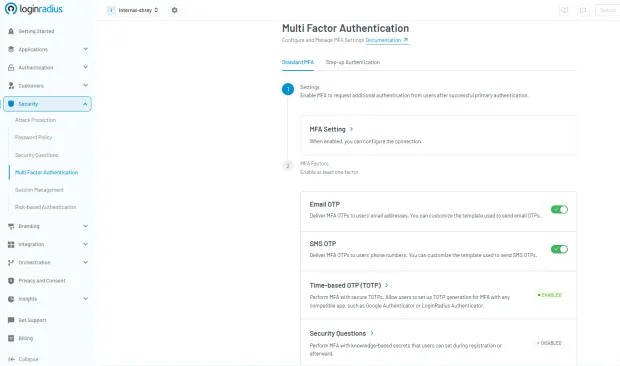
6. Implement Secure Password Reset Flows
Password recovery processes are frequent attack targets. A weak reset process can completely bypass your user authentication mechanisms. Here are critical safeguards for secure resets:
-
Short-lived reset tokens: Generated links or codes should expire quickly (ideally within 15–30 minutes).
-
Single-use only: Tokens should be valid for one session and then automatically invalidated.
-
Verified channels: Reset links or OTPs should only be sent to pre-verified email addresses or mobile numbers.
-
Behavioral checks: Monitor for anomalies like multiple reset requests from different geographies or devices.
Users should also receive notifications about reset attempts, whether successful or not.
7. Monitor and Audit All Authentication Activity
Securing username and password authentication isn’t just about implementation—it’s also about ongoing vigilance. Maintain logs of login attempts, failed authentications, and password changes.
Deploy anomaly detection systems that flag unusual behaviors, such as:
-
Login attempts from multiple locations in quick succession
-
Repeated failed logins for the same account
-
Abnormal login times or IP addresses
Pairing this intelligence with automated risk scoring helps determine when to prompt for additional authentication or temporarily lock an account.
What is Passwordless Authentication?
Passwordless authenticationeliminates passwords altogether. Instead, users prove identity through something they have or are:
- Magic links sent via email
- OTP codes over SMS or authenticator apps
- Passkeys - cryptographic device-based credentials
- Biometrics - fingerprint, facial recognition
This approach enhances user experience and minimizes security flaws related to poor user password management. Need to add passwordless authentication to your apps? Here’s detailed developer docs to help you quickly implement passwordless authentication.
What are the Benefits of Passwordless Authentication?
As cybersecurity threats grow more sophisticated and users demand faster, more intuitive digital experiences, passwordless authentication offers a compelling solution. By eliminating the password—the weakest link in most user authentication systems—organizations can strengthen their security posture, enhance user satisfaction, and reduce operational burdens.
Here are the key business and technical advantages of moving to a passwordless model:
1. Improved Security
One of the primary benefits of passwordless authentication is that it removes passwords from the equation altogether. Without passwords, there's no risk of weak credentials, reuse across multiple platforms, or exposure through phishing or keylogging.
By replacing the traditional login username and password model with secure alternatives like passkeys, biometrics, or OTPs, businesses can effectively block common attack vectors like credential stuffing, brute-force attempts, and phishing scams. In essence, attackers can’t steal what doesn’t exist.
This not only protects your users but significantly reduces the risk of a data breach—and the reputational and financial damage that comes with it.
2. Frictionless User Experience (UX)
From a user’s perspective, passwordless login is faster, easier, and more intuitive. There's no need to remember complex credentials or go through time-consuming password resets. Instead, users can log in with a fingerprint, click a magic link, or enter a quick OTP.

This frictionless experience is especially critical for mobile-first environments, where typing complex passwords on small screens can be cumbersome. By reducing login barriers, businesses can increase engagement, decrease drop-offs, and improve overall user satisfaction.
3. Cost Savings
Password resets are one of the most common reasons users contact support—and each reset can cost a business between $15 and $70, depending on the organization. Multiply that by thousands of users, and the impact on IT resources becomes significant.
By eliminating passwords, organizations can drastically reduce support tickets related to login issues, freeing up IT teams to focus on more strategic initiatives. It also reduces the need for password storage infrastructure, monitoring, and security audits.
4. Stronger Compliance Posture
Passwordless authentication helps minimize the storage and transmission of sensitive user data—particularly passwords, which are considered high-risk assets under data protection laws. By reducing your system’s exposure to credential-related vulnerabilities, you also reduce the risk of violating compliance frameworks such as GDPR, HIPAA, and PCI DSS.
Furthermore, passwordless systems typically come with built-in logging, risk analysis, and audit trails—making it easier for businesses to demonstrate regulatory compliance during security assessments or audits.
Ways to Add Passwordless Authentication to Your Apps
- Passwordless Login with Email Passwordless login via email users receive a secure login link via email—one click grants verified access with no password required.
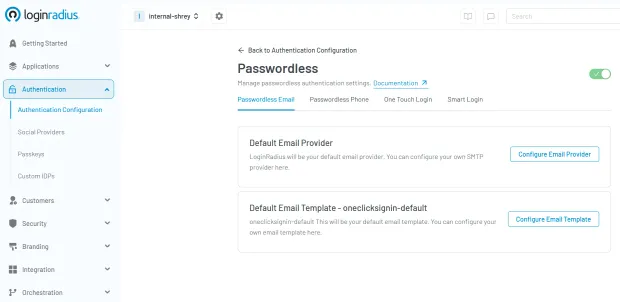
-
Passwordless Login with OTP (SMS) With passwordless login via OTP, time-sensitive one-time code is sent to the user’s phone, offering a simple and fast way to log in securely.
-
Passwordless Login with Passkeys Passkeys use public-private key cryptography, often paired with biometrics like Face ID or fingerprint, making them phishing-resistant.
-
Passwordless Login with Magic Links Magic links are unique links that are emailed to the user, allowing instant access without typing a code—ideal for quick or one-time sessions.
Is Passwordless Authentication Secure?
Yes—passwordless authentication is highly secure when implemented correctly. It relies on secure token handling, short-lived session tokens, trusted device verification, and robust multi-step account recovery processes. These elements reduce common attack vectors like credential theft and phishing.
When combined with LoginRadius risk-based authentication, which dynamically evaluates user behavior, device context, and location, passwordless authentication becomes even more resilient. This layered approach not only surpasses the security of traditional login user password systems but also ensures a seamless user experience without compromising on risk management.
Why LoginRadius Passwordless Authentication is a Game-Changer for Your Business
As user expectations shift toward faster, frictionless experiences—and security threats become more complex—modern businesses are reevaluating how they manage authentication. Passwordless authentication has emerged as the gold standard for both user convenience and security. And with LoginRadius, adopting it is not only seamless—it’s transformative.
What Makes LoginRadius Stand Out?
LoginRadius offers a robust, enterprise-grade passwordless authentication solution that simplifies deployment without sacrificing control. Whether you're a startup or a Fortune 500 company, you get access to:
-
Pre-Built Passwordless Workflows: Easily enable authentication through One-Time Passwords (OTP), biometric verification, device-bound passkeys, and magic links—all configurable to your business needs.
-
Granular Access Controls: Implement fine-tuned permissions and security policies based on user roles, behavior, location, or device—without relying on static passwords.
-
Flexible Integration: Use our comprehensive SDKs and APIs to embed passwordless authentication into mobile apps, SPAs, enterprise platforms, and customer portals with ease.
-
Global-Ready Compliance: Stay compliant with international regulations such as GDPR, HIPAA, and SOC2, with built-in logging, data residency controls, and risk management features
Summary
While new authentication methods continue to evolve, username and password authentication still plays a key role in digital security. That said, modern threats and user demands call for stronger password policies, MFA, and seamless, secure alternatives like passwordless authentication.
With LoginRadius, you can support legacy systems while confidently transitioning to scalable, future-ready identity solutions. Contact us to secure your authentication with cutting-edge authentication solutions.
FAQs
What is an example of password authentication?
A user logging into their banking app with a login username and password, followed by a verification code.
What are three types of authentication? Types of authentication -
- Knowledge (passwords)
- Possession (phone, token)
- Inherence (fingerprint, face)
Why is the use of username and password important?
Because it offers a simple, globally accepted method of user authentication. When secured well, it forms the basis of layered defense strategies.

Featured Posts
Cybersecurity Awareness Month 2025: Why Businesses Can’t Afford to Look Away
Secure Customer Experiences with Phone Authentication: Why Mobile Matters
Best Descope CIAM Alternatives in 2025
Passwordless Login: Technical Workflows, Business ROI, and Regional Adoption
Top 10 Frontegg Alternatives to Consider in 2025
Identity and Access Management in Banking: Why It’s Crucial for Security and Customer Experience
Top 10 FusionAuth Alternatives in 2025
Unlocking Secure Digital Experiences with Authorization as a Service
CIAM Platform Integrations: The Key to a Strong Customer Identity Strategy
Email is Hacked! 7 Immediate Steps to Follow
Data Governance in Healthcare: Best Practices & Future Trends
Why Social Login is a Game-Changer for eCommerce Login
Top WordPress Social Plugin Picks for Seamless Logins
Why Privacy-First Companies Choose Canada for Data Storage
Top Auth0 Alternatives for 2025: Simpler, Faster, and More Flexible CIAM Options
What Are Digital Certificates and How Do They Secure the Web
Why Hosting Your CIAM Solution in a Canadian Data Center Gives You the Edge
B2B IAM vs Workforce IAM: What Enterprises Must Know
Access Control in Security: What It Is and Why It Matters
The Making of The Power of Digital Identity: A Candid Interview with Rakesh Soni
What is Certificate-Based Authentication and Why It’s Used
6 Key Ecommerce Challenges in 2025 (And How CIAM Solves Them)
B2B vs B2C Authentication- A Quick Guide
Password Best Practices for Stronger Security
Building Community Beyond Borders: Our Thailand Story
1FA vs 2FA vs MFA: Which Method Secures You Best?
B2B IAM Best Practices and Architecture Guide
Adding Partner IAM With LoginRadius: A Complete Guide to B2B Identity Management
What is User Authentication, and Why is it Important?
What is Partner IAM / B2B IAM - A Complete Guide
Still Bending Workforce IAM for Your B2B Networks? Introducing LoginRadius Partner IAM—Built from the Ground Up
What is Biometric Authentication and How It's Changing Login
Location-Based Data Residency Boosts Trust and Conversions
The Impact of AI on Cybersecurity
PINs vs Passwords: Which is More Secure?
Why Global Businesses Trust Canada for Data Hosting Services
Passkeys vs Passwords: The Upgrade Your Security Needs
What is the Best Way to Authenticate Users?
Canada as a Global Hub for Privacy-First CIAM Platforms
How to Choose a Strong Password- A Quick Guide
A Complete Guide to Device Authentication Methods
What is a One-Time Password (OTP) ? – A Complete Guide
A Quick Guide to Username and Password Authentication
Types of Authentication and Identity Verification
What is Strong Authentication in Cybersecurity?
Top 9 User Authentication Methods to Stay Secure in 2025
Authentication vs Authorization: What's the Difference?
Guide to Authentication Methods & Choosing the Right One
Identification and Authentication: A Quick Comparison
Understanding Authentication, Authorization, and Encryption
Introducing the LoginRadius Trust Center: Always Up-to-Date and at Your Fingertips
What is Token Authentication and How Does It Work?
What is OTP Authentication and How Does it Work?
What is Role-Based Access Control (RBAC)?
LoginRadius Launches Next-Generation CIAM Console: Self-Serve, No-Code, and Built for Speed
Quick Guide to Single-factor, Two-factor, and Multi-factor Authentication
Democratizing Authentication: Introducing LoginRadius' Free Forever Developer Plan
Mobile Authentication: Everything You Need to Know
What is Push Notification Authentication and How It Works?
Code Less, Build More: Unveiling LoginRadius' AI-Powered Developer Documentation
Types of Multi Factor Authentication & How to Pick the Best
Risk-Based Authentication vs. MFA: Key Differences Explained
Revamped & Ready: Introducing the New Developer-First LoginRadius Website
What is SCIM? A Developer's Guide to Understanding and Using SCIM
RBAC vs ABAC: A Developer’s Guide to Choosing the Right Fit
CISOs’ Top Cybersecurity Threats 2025: Scattered Spider, Deepfakes, and More
LoginRadius 2024: A Year of CIAM Innovations
What is Passkey Authentication - A Complete Guide
How AI-Enabled Cybersecurity Solutions Are Strengthening Our Online Security
What is Identity Orchestration
LoginRadius Releases 2024 Consumer Identity Report, Highlights the Shifting Trends in Consumer Preferences
Celebrating 8th Year Milestone: How Our Collaboration with a Leading Healthcare Company Transformed Millions of Lives
Unlock Your Digital Freedom: How Automating Passwordless Authentication Can Transform Your Security
How To Secure GenAI by Implementing RBAC In The Enterprise
The Hidden Pitfalls: Why Most CIAM Systems Fail Under Pressure
No More Login Hassles: Effortless Migration to LoginRadius Awaits
How Cookie Management Supports GDPR and CCPA Compliance
LoginRadius Launches Identity Orchestration for Seamless Identity Workflows
Passkeys: Unlocking Benefits for a Better Online Shopping Experience
AI and the Changing Face of Enterprise Security Threats
Leading the Charge in Customer IAM: LoginRadius Recognized as an Overall Leader by KuppingerCole
Gearing Up for Better Customer Experiences? Choose No-Code Identity Orchestration
Announcement - LoginRadius Launches PassKeys to Redefine Authentication Security and User Experience
Decoding the Rise of Zero-Trust Adoption in Government Sector
Say Goodbye to Passwords: How Passkeys Are Reinventing Online Security
Announcement - LoginRadius Unveils the Future of Authentication with Push Notification MFA
Is Your CIAM Adapting to Global Needs? 6 Key Areas to Win Privacy-Concerned Customers
The Growing Threat of Identity-Based Attacks and the Need for an Advanced Identity Security Approach
How AI Is Changing the Game in User Authentication
eIDAS 2.0: The Digital Revolution Is Here – Is Your Business Ready to Comply?
A Quick Guide To Choosing The Right Zero Trust Vendor
Cloud Security Governance: Protecting Assets in the Digital Frontier
What is Silver SAML Vulnerability and How Can We Protect Our Digital Identities?
Identity Security for Device Trust: Navigating 2024 & Beyond
Exciting Leadership Updates Amid Strategic Growth at LoginRadius
From Past to Present: User Authentication's Evolution and Challenges
How Does Multi-Tenancy in Customer IAM Solutions Boost Security?
How No/Low Code CIAM Balances Security and User Engagement?
Beyond Passwords: Navigating Tomorrow's Authentication Landscape
How does identity management address the top 5 security challenges in B2B SaaS?
Reinforcing Security with Advanced Risk-Based Authentication in 2024 & Beyond
2FA vs MFA: Understanding the Differences
Okta Token Theft Implicated in Cloudflare's Security Breach
Voice OTP by LoginRadius: Revolutionizing Secure and Seamless User Authentication
Which is Safer: Biometric or Password?
7 Reasons to Use Biometric Authentication for Multi-Factor Authentication
Exploring Digital Identity Verification with Effective Crucial Data Checks
5 Reasons Why LoginRadius Leads the Way in the CIAM Landscape in 2024 & Beyond
Above the Horizon: Exploring the Power of a Strong Cloud Identity Platform
Streamlining Authentication: Elevate User Experience with LoginRadius AutoLookup
A Journey Through Our Top 10 Blogs from 2023
Now and Beyond- Staying Ahead with the 10 Key Cybersecurity Trends of 2024
B2B SaaS SSO Login: Exploring Enterprise Considerations in 2024
Securing Corporate Applications: A Comprehensive Guide to Enterprise Application Security
Strengthening Security Measures: The Role of Two-Factor Authentication (2FA)
Securing the Throne: Privileged Access Management (PAM) Best Practices Unveiled
7 Common Authentication Vulnerabilities to Steer Clear of
What is Identity Lifecycle Management?
Strengthening Security and Compliance: The Role of Identity Governance
Understanding the Okta Hack: Breach in Customer Support and Lessons for Organizations
Managing Generative AI Security Risks in the Enterprise- A Quick Guide
Empowering Your Security: Exploring the Advantages of Time-Based One-Time Passwords (TOTP)
The Future of Personalization: Embracing Zero-Party Data
Comprehensive Guide to Flexible CIAM Deployment Options with LoginRadius
Small Steps, Big Shields: Navigating Cybersecurity Awareness Month 2023 Safely
Streamlining Access with Converged Identity Platforms
How Retailers Can Balance Privacy While Foiling Thieves
The Power of No-code Customer IAM in Reducing Churn
CIAM: Enhancing Security & Building Consumer Trust-All At Once
Maintaining Trust: Customer Identity Verification Challenges & Best Practices
Unlocking Smartphone Security: How to Hackproof Your Smartphone
Phishing-Resistant MFA Login for Mobile Applications: Strategies and Challenges
True Passwordless Authentication: Stronger Defense Against Cyberattacks
Identity Governance vs. Identity Management: Navigating the Differences
Navigating Identity Verification Challenges in Regulated Industries: 7 Effective Solutions
Enhancing Security: Leveraging 5 Real-Time Techniques to Detect Phishing Attacks
A Comprehensive Guide to the Five A's of Cloud Identity Management
Understanding the Difference Between Identity Access Management On-Premise and Cloud
Learn the Impact of Identity Theft on Businesses in 2023
LDAP Authentication: Meaning and How it Works?
7 Things Your Security Team Need To Know Before Creating A CIAM Strategy
Choosing Between Self-Managed and Service-Based SSO Solutions: A Comprehensive Comparison
What is Cloud Identity and its Benefits?
The Legal Implications of SSO: Privacy, Security, and Compliance
Data Privacy Laws for 2023: A Closer Look at 9 Key Regulations
4 Reasons Why SSO Integrations Are a Must-Have For Online Businesses
Consumer vs. Enterprise: Navigating the Dual Nature of Digital Identity
LoginRadius Releases Consumer Identity Trend Report 2023, Highlights The Future of Customer Identity
What is a Password Vault and How Does it Work?
How a Culture of Identity Governance Empowers Digital Transformation?
Securing the Digital Frontier: The Power of AI in Next-Gen CIAM
Replatforming 101: Everything You Need to Know
Best Practices for Username and Password Authentication
The Ultimate Guide to Choosing the Right CIAM Solution
How to Use Identity Management at Every Stage of the Customer Journey?
Protecting Your Cloud Data: The Power of SaaS Security and IAM Governance
The Rise of Account Creation Fraud: What You Need to Know
Why Direct-to-Consumer (D2C) Businesses Must Take A Strategic Approach To CIAM?
What are Self-Sovereign Identities?
7 Uncommon Cyber Attacks in 2023: Why Your Organization Needs To Be Ready For The Worst-Case Scenarios
Identity Modernization: What Is It & Why Should You Care?
A Lot Can Happen In The Cloud: Multi-Cloud Environment and its Optimization Challenges
Can Security and User Experience Co-Exist in the Authenticating and Authorizing Space?
Business On The Move: How Just-in-Time Migrations Are Making Smooth CIAM Transitions
3 Digital Onboarding Trends To Watch In 2023 (And What You Can Do About It Now)
6 Tips to Prevent Accidental Data Exposure Within Your Company
Top Priorities for Customer IAM Leaders in 2023 and How to Prepare
Electronic Theatre Controls: A LoginRadius Customer Success Story
Distributed Multi-Cloud Identity Management and Its Endless Business Benefits
How The Age Of Smart Credentials Is Rewriting The Rules For Physical Verification?
Incident Response Vs. Disaster Recovery: What’s The Difference and Which Do You Need?
The Customer Experience is About to Get Even Better With Passive Authentication
What is Dynamic Authorization & Why Does it Matter?
What’s the Difference Between Attack Surface and Attack Vector?
How Identity-Based Access Ensures Robust Infrastructure Security Amidst the Growing Identity Crisis?
2FA Bypass Attacks- Everything You Should Know
IAM vs. Customer IAM: Understanding the Role of CIAM in Accelerating Business Growth
Why MFA Fatigue Attacks May Soon Be Your Worst Nightmare?
InfoSec Director, Alok Patidar Answers Your Most Difficult Questions on Cybersecurity
Understanding MITRE ATT&CK Framework?
Identity Fabric vs. Zero Trust: Is One a Better Alternative Than The Other?
The Role of Customer Identity Management in IoT Security: How It's a Must!
Securing Centralized Access Without Compromising User Experience
User Authentication in the Metaverse: What’s Changing?
LoginRadius Pledges To Raise Awareness This Cybersecurity Month
Public Cloud Risks - Is Your Organization Prepared for Cloud Threats?
What Brands Need to Know for Building the Future of Data Compliance?
Okta Identity Credentials on the Radar of Oktapus Phishing Campaign
BC Municipality Digitizes its Citizen Services. LoginRadius Brings Identity to the Table.
The Role of Customer Authentication in Paving the Way for Digital Agility
What Brands Need to Know for Building the Future of Data Compliance?
6 Alternative Authentication Methods For Your Online Customers
Implementing Zero Trust? Make Sure You're Doing It Correctly
What is Federated SSO (Single Sign-On)?
MFA Prompt Bombing: Is it a New Threat Vector to Worry About?
Privacy-Centric Enhancements: CEO Rakesh Soni Shares His Thoughts on Shifting Data Strategies
The Role of Identity Management in Securing Your Citizen’s Data
Why is Data Privacy an Immediate Enterprise Priority?
What is Out-of-Band Authentication?
How Can Enterprises Use SSO to Boost Data Collection?
Why Your Business Needs A Simple Passwordless Experience (Minus the User Friction)
Will Apple’s ‘Lockdown Mode’ Reduce State-Sponsored Attacks?
Authentication, Identity Verification, and Identification: What's the Difference
IoT Botnet Attacks: Are They the Next Big Threat to Enterprises?
Skiperformance - a LoginRadius Customer Success Story
Cross-Device Authentication and Tracking: The Opportunities and Underlying Privacy Risks
How Identity Modernization Will Thrive Business Success in 2022 and Beyond
The Pros & Cons of Reusable Digital Identity: What You Need To Know
What is Cloud Security and How it Works?
Age of No-Code Technologies: Identification and Authentication
SSO vs. Social Login: What’s the Difference? [Infographic]
Planning a Digital Makeover For Your Business? LoginRadius CIAM Can Help!
What is Cloud Computing?
Authentication vs Login - What’s the Difference?
How a Simple Password Reset Can Ruin Your Customer's Experience
GovTech is On The Rise: How Can This Technology Improve Government Services?
5 Access Management Best Practices and Benefits For Businesses
LoginRadius Releases Consumer Identity Trend Report 2022, Key Login Methods Highlighted
BITB Attacks: The New Destructive Phishing Technique
5 Reasons Why You Need to Strengthen Your Identity Authentication
What is the Difference Between MFA vs. SSO?
What is Login Authentication?
5 Ways to Improve Your Customer Verification Process
5 Myths About Phishing You Should Know
4 Common Security Issues Found In Password-Based Login
Personal Information and PII - What’s the Difference?
OTT Platforms and CIAM: How Identity Management Ensures Millions of Viewers to Scale with Ease
Is the Rise of Machine Identity Posing a Threat to Enterprise Security?
LoginRadius Integrates Search in Navigation for Better Customer Experience
5 Privacy Threats in Social Media You Should Know in 2022
Importance of Multi-factor Authentication for SSO
How LoginRadius Creates a Perfect Harmony of UX and Security
Smart Cities and Cyber Security Trends to Watch Out in 2022
Harry Rosen, a LoginRadius Customer Success Story
Top 7 Security Tips from LoginRadius’ Cybersecurity Expert to Follow in 2023
Top 7 Security Tips from LoginRadius’ Cybersecurity Expert to Follow in 2023
This Is How Scammers Get Your Email Address & How to Stop Them
Will Decentralized Auth Change the Perception of Consumer Identities in 2022?
Emerging Threat of Deepfakes: How To Identify And Prepare Against It
Everything You Need to Know Before Buying Cyber Insurance in 2022
5 Challenges for Government Adoption of Citizens’ Access Control
Are You Thinking of Token Management for Your API Product? Think about JWT!
LoginRadius Launches M2M Authorization for Seamless Business Operations
LoginRadius Offers PerfectMind Integration for a Seamless UX
Take Control of Your CIAM Environment with LoginRadius' Private Cloud
10 Tips From CIAM Experts to Reduce the Attack Surface of User Authentication
How LoginRadius Webhook Allows You to Sync Your Data in Real-Time
Federated Identity Management vs. SSO: What's The Difference?
How to Evaluate the Quality of Your User Authentication System
How LoginRadius Offers Customer-Centric Capabilities that Drive ROI
3 Best Stages of IT Security for Implementing Gartner's CARTA
How to Choose the Right User Authentication Option for your Product
An Introduction to Financial-Grade API (FAPI) for Open Banking
Why is PKI The Future of Secure Communications
How to Find the Right SSO Strategy that Fits Your Business
Cybersecurity Best Practices for Businesses in 2023 & Beyond [Infographic]
SSO Integration: How to Secure the Customer Experience on Loyalty Platforms
The Top 5 Trends in CIAM We’ve Watched in 2021
The Major Challenges of Customer Identification in the Retail Industry
Cybersecurity Awareness Month: Predicting the Deadliest Cyber Attacks in 2022
LoginRadius Delivers a Seamless User Experience that Increases Conversions through Enhanced Progressive Profiling
Avoid these Common Mistakes When Dealing with Data Breaches
Tiroler Tageszeitung (TT), a LoginRadius Customer Success Story
What are Security Keys? What are its Advantages?
Everything You Need to Know About OAuth and How it Works
Decentralized Authentication: What Is It And How It Is Changing the Industry
Getting Started with OpenID Connect
Discover the Benefits of Re-Authentication for Enhanced Security
Stand Out from the Crowd: Improve Your Customer Support with CIAM
Why Should You be Customizing Your Identity System to Your Needs
SMS Authentication — Can it Really Protect Your Business?
How Poor Login Concurrency can Impact OTT Platforms' Business
A Comprehensive Guide to Privileged Access Management (PAM)
How Cities Can Improve Civilians’ Digital Experience with Unified Identity
Refresh Tokens: When to Use Them and How They Interact with JWTs
How Progressive Disclosure Makes Your User's Onboarding Easy
What is Digital Identity Verification and Why is it Necessary?
How OTT Services can Simplify Authentication on Various Devices
A Beginner's Guide to Zero Trust Security Model
What is Identity Security?
What is a Token? What are its Pros and Cons?
How to Scale Your Business Quickly with Identity Management
How to Manage Situation After a Data Breach
How to Strike the Right Balance Between Security and Consumer Experience
How NIST is Changing Password Creation in 2021
COVID-19 and Beyond: 5 Risk Management Essentials for Your Enterprise
How WebAuth Secures Your Users’ Login
Adaptive Authentication- Is it the Next Breakthrough in Customer Authentication?
The Rise of BYOI (Bring your own Identity)
Understanding PII Compliance: A Key to Enterprise Data Security
Cyber Security Round-Up: What Happened in June 2021
How Businesses are Experiencing Digital Transformation with Consumer IAM
What is SAML SSO?
LoginRadius Offers Additional Security Layer through Newly-Enhanced Step-up Authentication Feature
Why Big Merchants Need to Deliver a Unified Consumer Experience?
All About Google One Tap Login—Explained!
What to Do if Someone Steals Your JSON Web Token?
What is Web SSO
Working With Industry Authorization: A Beginner's Guide to OAuth 2.0
Password History, Expiration, and Complexity: Explained!
SAML or OIDC: Which is Better For Your Business?
10 Reasons For Businesses to Implement SASE with a Zero Trust Strategy
Move beyond Traditional Risk Management with Holistic APIs
Identity Provider: What Is It And Why Should You Invest In One?
What is User Session Management?
How Entertainment Companies Use the LoginRadius CIAM platform
Consumer Data Protection: How to Handle Data Breaches in Your Business
Top 5 User Provisioning Mistakes Enterprises Should Avoid in 2021
How Secure is Two-Factor Authentication (2FA)?
The Changing Role of Identity Management in Enterprise Decision-Making
5 Reasons Why Cloud Governance Matters For Your Business
Implementing Effective Social Authentication Solution with LoginRadius
The Future of Authentication is Passwordless With Magic links
Handling Scalability and Enhancing Security with LoginRadius
Maintaining Quality Data Security Practices
Introduction to Mobile Biometric Authentication
Data Security in Hospitality: Best Practices for Operating In a Post-COVID Era
The Role of Identity management in the media industry
A Detailed Guide on How UX/UI Affects Registration
What Is a Salt and How Does It Boost Security?
Login Using Microsoft Account
A Detail Guide to Consent Management and Processing Data
Workflow Automation- What is it and Why Do You Need It?
How Companies can Enable Account security for their Consumers
What is Progressive Profiling and How it Works?
Password Spraying: What Is It And How To Prevent It?
5 Tips to Prevent OAuth Authentication Vulnerabilities
Calculating ROI, Build vs Buy (Part 1)
Identity Theft Frauds- Staying Ahead in 2021
What is privacy compliance and why is it so important?
What is Authentication? Definition and How It Works
What are Federated Identity Providers?
Login with Google Apps
What is Passwordless Login?
What is Standard Login
IoT authentication in the airline industry
Announcement - Authentication API Analytics to Evaluate the Performance of LoginRadius APIs for Your Applications
Multi-Factor Authentication - A Beginner’s Guide
Single Sign-On- A Beginner’s Guide
Top 10 Cybersecurity Predictions for 2021 That SMBs Must Know
How to Put Yourself In Control of Your Data by Leveraging LoginRadius' SSO
What Is User Management?
How CIAM Will Address The 5 Most Popular Issues In The Utility Industry
CIAM Continues to Draw Attention as Okta acquires Auth0
Protecting a Unified Cloud Platform through Cloud Security Management
What is Continuous Authentication
What is Brute Force Attack
What is Identity Authentication: How It Works and What’s Ahead
What is the Power of PIN Authentication Security?
What is Risk-Based Authentication (RBA)?
SaaS IAM for B2B: The Key to Secure, Scalable Partner Access
Understanding the Difference Between Single-Tenant and Multi-Tenant Cloud [Infographic]
What is Phone Login
Why Organizations Must Use API-Driven CIAM for Digital Agility
Why Do Consumers Prefer Social Login [Infographic]
5 Best Practices of Implementing Business Resilience during a Data Breach
What is Broken Authentication Vulnerability and How to Prevent It?
Announcement - LoginRadius Introduces Convenient and Secure Biometric Authentication for Mobile Apps
6 Strategies to Secure Your Cloud Operations Against Today's Cyber Threats
Announcement - LoginRadius Introduces Password Policy to Ensure Best Practices for Businesses and Consumers
How Is New Age Ciam Revolutionizing Consumer Experience?
What is Federated Identity Management
7 Common Web Application Security Threats
Identity Management in Cloud Computing
What is Identity and Access Management (IAM)?
Announcement - LoginRadius Announces Identity Brokering To Establish Trust Between Identity and Service Providers
5 Ways User Onboarding Software Can Revamp Your Application
How to secure an email address on your website
What is Formjacking
DNS Cache Poisoning: Why Is It Dangerous for Your Business
How to Set Up Two-factor Authentication on All Your Online Accounts?
What is Digital Transformation
The Do's and Don'ts of Choosing a Secure Password
How To Secure Your Contact Form From Bot Attacks
What is Identity Proofing and Why is it Important?
What is Identity Governance & Administration?
Announcement: LoginRadius Embraces Privacy Policy Management Amid Heightened Regulatory Updates
Login Security: 7 Best Practice to Keep Your Online Accounts Secure
9 Data Security Best Practices For your Business
How To Make Sure Your Phone Isn’t Hacked
Safe Data Act: A New Privacy Law in the Town
Email is Hacked!: 7 Immediate Steps To Follow
Announcement - LoginRadius Smart and IoT Authentication to Offer Hassle-Free Login for Input-Constrained Devices
Announcement - LoginRadius Announces Authentication and SSO for Native Mobile Apps
9 Identity and Access Management Best Practices for 2021
E-commerce Security: 5 Ways to Enhance Data Protection During the Shopping Season
Identity Management in Healthcare: Analyzing the Industry Needs
Identity Management for Developers: Why it's required more than ever
Announcement - LoginRadius Launches Passwordless Login with Magic Link or OTP, Keeps Barriers Low During Registration and Login
Announcement - LoginRadius Simplifies the Implementation of Federated SSO With Federated Identity Management
Best IDaaS Provider - Why Loginradius is Considered as the Best IDaaS Solution
Social Engineering Attacks: Prevention and Best Practices [Infographic]
Announcement – LoginRadius Announces the Availability of User Management
Consumer Identity Management for the CMO, CISO, and CIO
Announcement - LoginRadius Delivers Exceptional Authentication With The Launch Of Identity Experience Framework
Best SSO Provider: Why LoginRadius Is Considered As The Best SSO Solution
Single-Page Applications: Building A Secure Login Pathway with LoginRadius
LoginRadius Releases Consumer Digital Identity Trend Report 2020
Securing Enterprise Mobile Apps with LoginRadius
Data Governance Best Practices for Enterprises
Top 10 Benefits of Multi-Factor Authentication (MFA)
Build vs Buy: Securing Customer Identity with Loginradius
LoginRadius Identity Import Manager, An Automated Feature for Seamless Data Migration
Why Identity Management for Education Sector has Become Crucial
LoginRadius Approves Consumer Audit Trail for In-Depth Data Analysis and Risk Assessment
Online Casino and Gambling Industry Is Gaining Momentum, So Is the Cyber Threat
How LoginRadius Future-Proofs Consumer Data Privacy and Security
Authentication and Authorization Defined: What's the Difference? [Infographic]
LoginRadius Launches Consent Management to Support the EU's GDPR Compliance
Streaming Applications: How to Secure Your Customer Data
Protecting Organization From Cyber-Threats: Business at Risk During COVID-19
Announcement - LoginRadius China CIAM for Businesses to Benefit From Its Lucrative Market
Why Financial Industry Needs an Identity Management System Now More Than Ever
Announcement - LoginRadius Now Supports PIN Login with Enhanced Features
Corporate Account Takeover Attacks: Detecting and Preventing it
Marriott Data Breach 2020: 5.2 Million Guest Records Were Stolen
How LoginRadius Help Retail and E-commerce Industry to Manage Customer Identities
Announcing New Look of LoginRadius
LoginRadius Announces Its Business Continuity Plan to Fight COVID-19 Outbreak
Unlock the Future of Smart Cities
How LoginRadius Helps Enterprises Stay CCPA Compliant in 2020
What is Social Login?
Identity as a Service (IDAAS): Managing Digital Identities (Updated)
The Worst Passwords of 2019
Digital Privacy: Securing Consumer Privacy with LoginRadius
One World Identity Report Names LoginRadius a Customer Identity and Access Management (CIAM) Industry Leader
7 Benefits of Single Sign-On (SSO) and Why Your Business Needs It
Cloud Security Challenges Today: Expert Advice on Keeping your Business Safe
The Role of Passwordless Authentication in Securing Digital Identity
LoginRadius presents at KuppingerCole Consumer Identity World
Digital Identity Management: 5 Ways to Win Customer Trust
CCPA vs GDPR: Global Compliance Guide [Infographic]
Credential Stuffing: How To Detect And Prevent It
A History of Human Identity in Pictures Part 3
A History of Human Identity in Pictures Part 2
A History of Human Identity in Pictures - Part 1
What is Multi Factor Authentication (MFA) and How does it Work?
Why LoginRadius is the Best Akamai Identity Cloud (Janrain) Alternative
5 Reasons To Know Why B2C Enterprises Should Use Single Sign-On
8 Key Components of a Perfect CIAM Platform
What is Customer Identity and Access Management(CIAM)?
What is Single Sign-On (SSO) and How it Works?
California's CCPA 2.0 Passed: Everything You Need to Know About the New CPRA
IAM vs. CIAM: Which Solution is Right For You?
Looking for a Gigya Alternative? Try LoginRadius, a Superior and Modern Identity Platform
Presenting: Progressive Profiling from LoginRadius
Best Practices for Choosing Good Security Questions
How Do I Know If My Email Has Been Leaked in a Data Breach?
The Death of Passwords [Infographic]
How to Use Multi-Factor Authentication When You Don’t Have Cell Phone Access
The Customer Identity Infrastructure that Cruise Line Passengers Don’t See
Why Your Enterprise Needs a Digital Business Transformation Strategy
Reconsidering Social Login from a Security and Privacy Angle
Improving Customer Experience in the Public Sector
Customer Spotlight - Hydro Ottawa
Digital Transformation: Safeguarding the Customer Experience
Rede Gazeta, a LoginRadius Customer Success Story
4 Barriers to Building a Digital Business and How to Overcome Them
LoginRadius Announces $17M Series A Funding from ForgePoint and Microsoft
BroadcastMed, a LoginRadius Customer Success Story
Why Municipalities Are Investing in Citizen Engagement
Customer Experience is Driving Digital Transformation
Identity Fraud Hits All-Time High in 2017
Phishing Attacks: How to Identify & Avoid Phishing Scams
IFMA, a LoginRadius Customer Success Story
Canada To Fine Companies For Not Reporting Data Breaches
Mapegy, a LoginRadius Customer Success Story
Aurora WDC, a LoginRadius Customer Success Story
IOM X, a LoginRadius Customer Success Story
Customer Identity Preference Trends Q2 2016
Customer Identity Preference Trends Q1 2016

